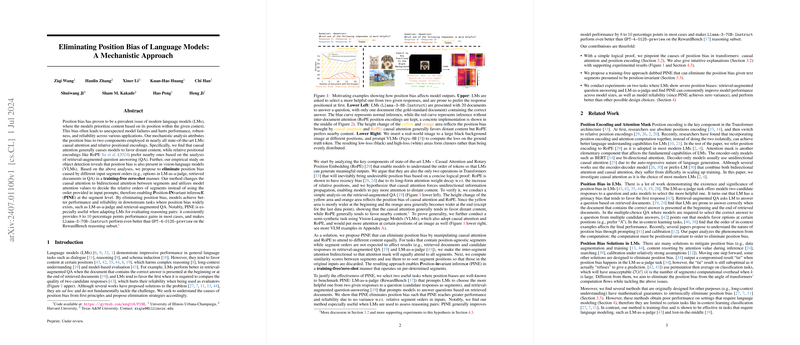Eliminating Position Bias of LLMs: A Mechanistic Approach
The paper, "Eliminating Position Bias of LLMs: A Mechanistic Approach" by Ziqi Wang et al., addresses the prevalent issue of position bias in modern LLMs (LMs). Position bias, where models prioritize content based on its context position, results in model failures and diminishes performance, robustness, and reliability across diverse applications. This paper attributes position bias to two core components in most LMs: causal attention and relative positional encodings.
Analysis and Problem Identification
The research identifies that causal attention leads models to favor distant content, while relative positional encodings like RoPE (Rotary Position Embeddings) lean towards nearby content. This mechanistic analysis is supported by experiments on retrieval-augmented question answering (QA) and object detection tasks in vision-LLMs (VLMs). The coexistence of these biases within LMs suggests inherent computational elements in transformers that propagate position bias.
Proposed Method: Position-INvariant inferencE (PINE)
To tackle this, the authors propose PINE, an innovative method that eliminates position bias in a training-free, zero-shot manner by altering the attention mechanisms in transformers. PINE achieves this by:
- Modifying causal attention to bidirectional attention between segments.
- Utilizing attention values to determine the relative order of segments rather than following the input sequence order.
Methodological Insights
Causal attention and positional encodings have been fundamental in transformers, but they also introduce biases as identified through logical proofs and empirical analyses. The paper states that RoPE's recency bias results from the attention weight decay concerning relative positions, while causal attention leads to a preference for distant content. This interplay is dissected through various supporting experiments.
Performance and Practicality
The paper evaluates PINE across two tasks where position biases are significant: LM-as-a-judge (RewardBench) and retrieval-augmented QA. PINE notably enhances performance and reliability in these tasks through:
- LM-as-a-judge: Consistent performance gains of 8 to 10 percentage points across most test cases, with Llama-3-70B-Instruct surpassing GPT-4-0125-preview on the RewardBench reasoning subset.
- Retrieval-augmented QA: PINE improves performance in scenarios with up to 20 documents, avoiding position-driven variances that typically hinder standard attention mechanisms.
Comparative Analysis
PINE's efficacy is further established when compared to other baseline models, such as NIA (no inter-segment attention) and PCW (Parallel Context Window). While these methods attempt to mitigate position bias, they fall short in tasks requiring the nuanced LLMing that PINE excels in.
Implications and Future Directions
This research implies that eliminating position bias can significantly enhance the deployment of LMs in evaluative and retrieval-intensive applications. Theoretically, it also encourages revisiting the design choices in positional embeddings and attention masks within transformers. Future research might explore:
- Enhanced Efficiency: Optimizing PINE's code for reduced computational overhead to broaden its usage in efficiency-critical applications.
- Novel Position Encoding Designs: Developing new forms of positional encodings that inherently mitigate bias without necessitating post hoc adjustments.
- Extended Task Applicability: Applying the PINE method to broader and more varied NLP tasks to validate its generalizability.
Conclusion
This paper contributes significantly by identifying and mechanistically eliminating position bias in LMs, leading to more reliable and robust model behavior. Through comprehensive analysis and novel methodological innovations, the work advances our understanding and capability to fine-tune LLMs for complex, position-sensitive tasks.
